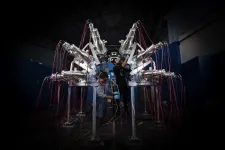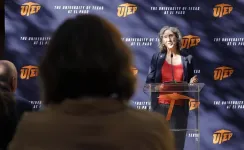(Press-News.org) A project mapping medieval England’s known murder cases has now added Oxford and York to its street plan of London’s 14th century slayings, and found that Oxford’s student population was by far the most lethally violent of all social or professional groups in any of the three cities.
The team behind the Medieval Murder Maps – a digital resource that plots crime scenes based on translated investigations from 700-year-old coroners’ inquests – estimate the per capita homicide rate in Oxford to have been 4-5 times higher than late medieval London or York.
Among Oxford perpetrators with a known background, 75% were identified by the coroner as “clericus”, as were 72% of all Oxford’s homicide victims. During this period, clericus is most likely to refer to a student or member of the early university.
“A medieval university city such as Oxford had a deadly mix of conditions,” said Prof Manuel Eisner, lead murder map investigator and Director of Cambridge’s Institute of Criminology.
“Oxford students were all male and typically aged between fourteen and twenty-one, the peak for violence and risk-taking. These were young men freed from tight controls of family, parish or guild, and thrust into an environment full of weapons, with ample access to alehouses and sex workers.”
“As well as clashes between town and gown, many students belonged to regional fraternities called ‘nations’, an additional source of conflict within the student body,” said Eisner.
A new website, launched today by Cambridge’s Violence Research Centre, allows users to compare the causes and patterns of urban violence in medieval England across three cities for the first time.
The site features a new map of York’s homicides during its 14th century “golden age” when – driven by trade and textiles – the city flourished as Black Death subsided. Many of the York cases document feuds between artisans in the same profession, from knife fights amongst tannery workers to fatal violence between glove-makers.
Coroners’ rolls are catalogues of sudden or suspicious deaths as deduced by a jury of local residents. Recorded in Latin, they included names, events, locations, and even the value of murder weapons.
Using the rolls and maps from the Historic Towns Trust, researchers have constructed a street atlas of 354 homicides across all three cities. Dozens of these cases now have audio versions of the inquests, so users can listen to details of the more intriguing medieval casefiles.
The original London map, published in 2018, has been remodelled and updated to include accidents, sudden deaths, sanctuary church cases, and deaths in prison – all of which the coroner recorded.
Sanctuary church incidents involved an alleged felon fleeing to holy ground, which allowed them forty days to negotiate with the coroner. This situation often resulted in banishment from the realm: the felon confesses and is directed to an agreed port through which they left England for good.
“When a suspected murder victim was discovered in late medieval England the coroner would be sought, and the local bailiff would assemble a jury to investigate,” said Eisner.
“A typical jury consisted of local men of good repute. Their task was to establish the course of events by hearing witnesses, assessing any evidence, and then naming a suspect. These indictments were summarised by the coroner’s scribe.”
These reports were a combination of detective work and rumour, say researchers. Some juries strategically constructed narratives aimed at influencing verdicts such as self-defence.
“We do not have any evidence to show juries wilfully lied, but many inquests will have been a 'best guess' based on available information,” said Cambridge historian and co-researcher Dr Stephanie Brown. “In many instances, it is likely the jury named the right suspect, in others it may be a case of two plus two equals five.”
By the early 14th century Oxford was one of the most significant centres of learning in Europe. The city had a population of around 7,000 inhabitants, with perhaps 1,500 students.
Based on their research, Eisner and Brown estimate the homicide rate in late medieval Oxford to work out around 60-75 per 100,000. This is some 50 times higher than current rates in 21st century English cities. The mix of young male students and booze was often a powder keg for violence.
A Thursday night in 1298 saw an argument between students in an Oxford High Street tavern result in a mass street brawl with swords and battle-axes. The coroner recorded student John Burel had “a mortal wound on the crown of his head, six inches long and in depth reaching to the brain”.
Interactions with sex workers could end tragically when students became violent. One unknown scholar got away with murdering Margery de Hereford in the parish of St. Aldate in 1299 when he fled after stabbing her to death instead of paying what he owed for intercourse.
In another incident, a gang of students killed one of their own, David de Trempedhwy, after he brought back a “harlot” named Christiana of Worcester to their school in the winter of 1296. They also escaped justice.
Some Oxford cases reveal rifts among scholars from different parts of the British Isles. Lodgings were often arranged according to students’ home regions, and friction between northerners and southerners, or the Irish, Welsh and English, was common.
In the spring of 1303, student Adam de Sarum was playing with a ball in the street when he was set upon by a trio of Irish scholars, who stabbed him in the face and throat. Just a month earlier, two Welsh scholars assaulted some passing students who raised a “hue”, at which point a student from Durham attempted to intervene and was beaten to death.
“Before modern policing, victims or witnesses had a legal responsibility to alert the community to a crime by shouting and making noise. This was known as raising a hue and cry,” said Dr Stephanie Brown. “It was mostly women who raised hue and cry, usually reporting conflicts between men in order to keep the peace.”
Many cases involve the intervention of bystanders, whether summoned by “hue” or not, who end up as victims or indeed perpetrators. “There was an expectation on adult men that maintaining order was part of your social responsibility,” said Eisner.
The medieval sense of street justice coupled with the ubiquity of weaponry in everyday life meant that even minor infractions could lead to murder. London’s cases include altercations that began over eel-skin littering and careless urination, only to end in homicide.
“Knives were omnipresent in medieval society,” said Brown. Many cases feature a knife called a thwytel, later evolved to the word ‘whittle’. “A thwytel was a small knife, often valued at one penny, and used as cutlery or for everyday tasks. Axes were commonplace in homes for cutting wood, and many men carried a staff.” Some 12% of London’s homicides were committed with a sword.
Even officials of public order – bailiffs, constables, and sergeants – were far from safe. Richard Overhe, a preserver of the “King’s peace”, was brutally attacked by four Oxford students “with swords, bucklers and other arms” during a summer’s night in 1324, and found dead in his home.
Added Eisner: “Circumstances that frequently led to violence will be familiar to us today, such as young men with group affiliations pursuing sex and alcohol during periods of leisure on the weekends. Weapons were never far away, and male honour had to be protected.”
“Life in medieval urban centres could be rough, but it was by no means lawless. The community understood their rights and used the law when conflicts emerged. Each case provides a glimpse of the dynamics that created a burst of violence on a street in England some seven centuries ago.”
NOTES:
London’s remaining rolls cover nine of the years between 1300 and 1340. York’s date to between 1345 and 1385. A complete set for Oxford survives for six years preceding 1348, just before the bubonic plague hit the city. Partial Oxford records also exist for fifteen of the years between 1296 and 1324.
END
Students made Oxford the murder capital of late medieval England, research suggests
2023-09-28
ELSE PRESS RELEASES FROM THIS DATE:
Risk of premature birth from smoking while pregnant more than double previous estimates
2023-09-28
Cambridge researchers have found that women who smoke during pregnancy are 2.6 times more likely to give birth prematurely compared to non-smokers – more than double the previous estimate.
The study, published today in the International Journal of Epidemiology, also found that smoking meant that the baby was four times more likely to be small for its gestational age, putting it at risk of potentially serious complications including breathing difficulties and infections.
But the team found no evidence that caffeine intake was linked to adverse outcomes.
Women are currently recommended to stop smoking and limit their caffeine intake during pregnancy because of the risk of complications ...
Women seeking credibility in health care feel ‘on trial,’ struggle with constraints of double binds
2023-09-28
CHAMPAIGN, Ill. — Having a chronic illness is a great deal of work, communication researchers have long known. But having an illness that is stigmatized, not well understood or not perceived as a priority by clinicians is uniquely burdensome for many women, who find themselves struggling to establish both the legitimacy of their medical problems and their credibility with clinicians, family members and friends, a recent study suggests.
Sasha, a 25-year-old woman interviewed for the project, told the researchers she has a binder 3 inches thick containing all her medical records that she lugs to every doctor’s appointment to provide documentation ...
Chi-Nu experiment ends with data to support nuclear security, energy reactors
2023-09-28
The results of the Chi-Nu physics experiment at Los Alamos National Laboratory have contributed essential, never-before-observed data for enhancing nuclear security applications, understanding criticality safety and designing fast-neutron energy reactors. The Chi-Nu project, a years-long experiment measuring the energy spectrum of neutrons emitted from neutron-induced fission, recently concluded the most detailed and extensive uncertainty analysis of the three major actinide elements — uranium-238, uranium-235 and plutonium-239.
“Nuclear fission and related nuclear chain ...
Researchers dynamically tune friction in graphene
2023-09-28
The friction on a graphene surface can be dynamically tuned using external electric fields, according to researchers at the University of Illinois Urbana-Champaign led by Professor Rosa Espinosa-Marzal of the Department of Civil and Environmental Engineering. The work is detailed in the paper, “Dynamically tuning friction at the graphene interface using the field effect,” published September 19, 2023, in the journal Nature Communications.
Friction plays a key role in both natural and engineered systems, dictating the behavior of sliding contacts, affecting ...
Polyps as pixels: innovative technique maps biochemistry of coral reefs
2023-09-27
Using an innovative new approach to sampling corals, researchers at the University of Hawai‘i (UH) at Mānoa are now able to create maps of coral biochemistry that reveal with unprecedented detail the distribution of compounds that are integral to the healthy functioning of reefs. Their study was published today in Communications Biology.
“This work is a major step in understanding the coral holobiont [the coral animal and all of its associated microorganisms], which is critical for reef restoration and management,” said lead author Ty Roach, who conducted this study as a postdoctoral researcher at the Hawai‘i Institute of Marine Biology (HIMB) in the UH ...
Study shows how brain tumors make certain immune cells turn traitor
2023-09-27
September 27, 2023, NEW YORK – A Ludwig Cancer Research study has for the first time exhaustively analyzed immune cells known as neutrophils that reside in brain tumors, including gliomas, which develop in the brain itself, and cancers that spread there from the lung, breast and skin.
Led by Ludwig Lausanne’s Johanna Joyce and Roeltje Maas, an MD-PhD student in her laboratory, the study also details the key role neutrophils play in ensuring the survival of brain cancers and exposes the mechanisms by which the tumor microenvironment (TME) tweaks their biology to turn them into enablers of malignant growth. Its findings suggest new approaches ...
State politics, industry drive planetary health education for K-12 students in US
2023-09-27
CHAMPAIGN, Ill. — As much of the U.S. broils under record-setting temperatures, battles wildfires and is rocked by fierce storms, a new study suggests that the science learning standards for many public schools are not preparing young people to understand and respond to problems such as climate change that will dramatically impact their lives and those of millions of people around the globe.
Published in the Proceedings of the Royal Society B: Biological Science, the findings raise troubling questions about political bias shaping if and what the nation’s ...
UCLA-led team develops key improvement to Nobel Prize-winning technology
2023-09-27
The scientists who received the 2017 Nobel Prize in chemistry were honored for their development of a technique called cryo-electron microscopy, or cryo-EM. The technology was revolutionary because it enabled scientists to see the atomic structure of biological molecules in high resolution.
But cryo-EM still had a catch: It was only effective for imaging large molecules.
Now, UCLA biochemists, working with pharmaceutical industry scientists, have developed a solution that will make it possible for cryo-EM to acquire high-quality images of smaller protein molecules, too. The scientists engineered a 20 nanometer, cube-shaped ...
UTEP awarded $7 million to support Hispanic-serving institutions across the country
2023-09-27
EL PASO, Texas (Sept. 27, 2023) — The University of Texas at El Paso has been chosen to become a center of thought leadership for Hispanic Serving Institutions (HSIs) across the country, thanks to a new $7 million grant from the National Science Foundation (NSF).
The new grant, known as NODE (Network Opportunities for Developing Equitable and Effective Evaluation at HSIs), is a six-year investment that will position UTEP to provide the first full portrait of the effectiveness of all grants funded by the NSF HSI program. Anne-Marie Núñez, Ph.D., executive director of the Diana Natalicio Institute ...
JWST's first spectrum of a TRAPPIST-1 planet
2023-09-27
Image
In a solar system called TRAPPIST-1, 40 light years from the sun, seven Earth-sized planets revolve around a cold star.
Astronomers obtained new data from the James Webb Space Telescope (JWST) on TRAPPIST-1 b, the planet in the TRAPPIST-1 solar system closest to its star. These new observations offer insights into how its star can affect observations of exoplanets in the habitable zone of cool stars. In the habitable zone, liquid water can still exist on the orbiting planet's surface.
The ...






